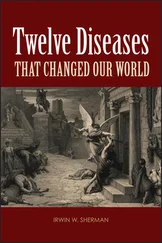1 ...6 7 8 10 11 12 ...30 Measles spreads from person to person by sneezing and coughing; the virus particles are hardy and can survive as long as 2 h on doorknobs, handrails, elevator buttons, and even in air. For the first 10 to 14 days after infection, there are no signs or symptoms. A mild to moderate fever, often accompanied by a persistent cough, runny nose, inflamed eyes (conjunctivitis), and sore throat, follows. This relatively mild illness may last 2 or 3 days. Over the next few days, the rash spreads down the arms and trunk, then over the thighs, lower legs, and feet. At the same time, fever rises sharply, often as high as 104 to 105.8ºF (40 to 41ºC). The rash gradually recedes, and usually lifelong immunity follows recovery. Complications, which may include diarrhea, blindness, inflammation of the brain, and pneumonia, occur in ~30% of cases. Between 1912 and 1916 there were 5,300 measles deaths per year in the United States. Yet all that changed in 1968 with the introduction of the measles vaccine; in the United States, measles was declared eliminated in 2000.
What, then, underlies the Disneyland outbreak?
On average, every measles-infected person is able to spread the disease to ten other people, i.e., its R 0value is 10. With this multiplier, measles will spread explosively; indeed, with multiplication every 2 weeks and without any effective control (such as immunization), millions could become infected in a few months. It has been estimated that to eliminate measles (and whooping cough) ~95% of children under the age of 2 must be immunized. For disease elimination not everyone in the population need be immunized, but it is necessary to reduce the number of susceptible individuals below a critical point (called herd immunity).
An analysis of the Disneyland outbreak of measles shows that that those infected were unvaccinated. The researchers have calculated that the number of vaccinated individuals might have been as low as 50%. The outbreak that began in California was a reflection of the anti-vaccination movement, which had led some parents to believe the false claim that the vaccine for measles caused an increase in autism. (The “evidence” for this was based on just 12 children and has been thoroughly discredited by massive studies involving half a million children in Denmark and 2 million children in Sweden.) Then, too, some parents believe their children are being immunized too often and with too much vaccine because pharmaceutical companies are recklessly promoting vaccination in pursuit of profit. Other parents contend that the vaccine is in itself dangerous. It is not, as is evidenced in Orange County, where Disneyland is located: the outbreak sickened 35 people, including 14 children. And although a measles vaccine has been available worldwide for decades, according to the WHO, about 400 people a day died in 2013.
The response to the outbreak at Disneyland prompted the California Senate to pass a bill, SB 277, which required almost all California schoolchildren to be fully vaccinated in order to attend public or private school, regardless of their parents’ personal or religious beliefs. In signing the bill, Governor Edmund G. (Jerry) Brown wrote: “While it is true that no medical intervention is without risk, the evidence shows that immunization powerfully benefits and protects the community.”
“A recurrent problem for all parasites … is how to get from one host to another in a world in which such hosts are never contiguous entities,” wrote the historian William McNeill. He went on: “Prolonged interaction between human host and infectious organisms, carried on across many generations and among suitably numerous populations on each side, creates a pattern of mutual adaptation to survive. A disease organism that kills its host quickly creates a crisis for itself since a new host must somehow be found often enough and soon enough, to keep its chain of generations going.” Based on this view, it would seem obvious that the longer the host lives, the greater the possibility for the parasite to grow, reproduce, and disperse its infective stages to new hosts. The conventional wisdom, therefore, is that the most successful parasites are those that cause the least harm to the host, and over time virulent parasites would tend to become benign.
At first glance, it would appear that the progress of the disease myxomatosis in Australia supports this evolutionary perspective. The story of myxomatosis begins in 1839, when the Austin family migrated from England to Australia. Over time they became rich from sheep farming. To reestablish their English environment, the Austins imported furniture, goods, and a variety of animals. In 1859 a ship came from England to Australia with rabbits. Since the rabbits had no natural predators, they multiplied rapidly, destroying plants and the native animals. The Austins began to wage war on the rabbits. By 1865, >20,000 rabbits were killed on the Austin estate. And still the rabbits continued to spread, traveling as much as 70 miles per year. Control measures such as fences, barbed wire, ditches, and the like did not work. A viral disease of wild rabbits from South America, called myxomatosis and lethal to domestic rabbits, was introduced into Australia in the 1950s to act as a biological control agent. The vector for the myxoma virus is a mosquito. In 1950, 99% of the rabbits died of myxomatosis. Several years later the virus killed only 90%, and it declined in lethality with subsequent outbreaks. It was also found that the viruses from the later epidemics were less virulent than the earlier forms and that these less virulent forms were much better at being transmitted by mosquitoes—the rabbits lived longer and the number of infected rabbits was higher with milder disease. One may conclude that the virus had evolved toward benign coexistence with the rabbit host. McNeill, impressed by the results of the introduction of the myxoma virus into Australia, wrote: “from an ecological point of view … many of the most lethal disease-causing organisms are poorly adjusted to their role as parasites … and are in the early stages of biological adaptation to their human host; though one must not assume that prolonged co-existence necessarily leads toward mutual harmlessness. Through a process of mutual accommodation between host and parasite … they arrive at a mutually tolerable arrangement … (and based on myxomatosis) … some 120-150 years are needed for a human population to stabilize their response to drastic new infections.” There is, however, reason to question McNeill’s conclusions.
A recent reexamination of myxomatosis in Australia shows that the mortality of the rabbits, after the decrease in the virulence of the virus and the increase in rabbit resistance, was comparable to the mortality of most vector-borne diseases of humans, such as malaria. In other words, the virus was hardly becoming benign. Further, the decrease in virulence observed over the first 10 years of the study did not continue, but reversed. It appears that myxomatosis is not an example of benign evolution.
An alternative to the contention that parasites evolve toward a harmless state is that natural selection favors an intermediate level of virulence. This intermediate level is the result of a trade-off between parasite transmission and parasite-induced death. Since the value for R 0increases with the transmission rate as well as the duration of the host’s infectiousness, an increase in transmission would reduce the duration of infection, and then selection may favor intermediate virulence. And because R 0depends directly on the density of susceptible hosts, if the number of susceptible individuals is great, then a parasite may benefit from an increased rate of transmission even if this kills the host sooner and prevents transmission at a later time. If susceptible hosts are not abundant, however, then the parasite that causes less harm to the host (i.e., is less virulent) may be favored since that would allow the host to live longer, thereby providing more time for the production of transmission stages. The hypothesis that virulence is always favored when hosts are plentiful and is reduced when there are fewer hosts neglects the fact that a feedback exists in the host-parasite interaction: a change in parasite virulence impacts the density of the host population, and this in turn alters the pressures of natural selection on the parasite population, and so on. Thus, although parasite virulence generally tends to decline over evolutionary time, it never becomes entirely benign, and in the process the parasite population becomes more efficient in regulating the size of the susceptible host population.
Читать дальше












